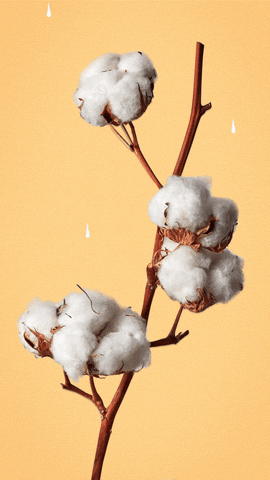- À New Wave to Fashion, À New Way of Living. Download Now on iOS Android Canada SS22
- hello@alahausse.ca
The Dirty Little Secret Behind Cotton

The Woke Hypebeast: Why and How Hip Hop Can Inspire Ethical and Sustainable Fashion
February 18, 2021
A Profile on the Environmental Impact of Wool
February 23, 2021Written By: Sheila Lau
Over the past few years, more people are becoming aware of how the clothes they buy are contributing to the world’s plastic problem. This has led to pushback against synthetic fibers (like polyester, nylon, and acrylic), and led to adoption of natural and organic fibers instead, such as using cotton, wool, hemp, and bamboo. The fashion industry is also responding by looking for more sustainable means of production and raw materials.
While avoiding synthetic fibers may help reduce plastic waste, we may still be harming the earth in other ways. In the following series, we will examine the impact of each natural fiber source on how clean and green they really are. In the first part of our natural fiber series, we will look at the impact of cotton. The next parts of our series will look at wool, hemp, and bamboo.
Conventional Cotton
Cotton is one of the most environmentally demanding crops to grow. Growing cotton is water-intensive, requiring around 40,000 to 75,000 liters of water for one pair of jeans and over 10,000 liters of water to make one T-shirt. Some experts believe that cotton is the single largest water user among all agricultural products. Pakistan, one of the top cotton producers in the world, has used 97% of the water in the Indus River (their main water source) to grow cotton. Diversion of surface and ground water for the irrigation of cotton fields has also led to freshwater loss and inefficient water management.
Not only is cotton water-intensive, but it also uses a large amount of pesticides and toxic chemicals. Fashion for Good reports that cotton production accounts for 24% of all insecticides used in the world. The United States, the largest global cotton exporter, uses a quarter of its pesticides on just producing cotton. These chemicals leach into the soil and groundwater, and remain as persistent organic pollutants that harm farmers and local communities for many years after.
Even if pollutants are not directly inhaled by local residents, they affect communities through food and water contamination, impacting human health, animal welfare, and soil and water quality. In fact, the World Health Organization shows that approximately 20,000 individuals in developing countries die of cancer or suffer miscarriages due to the spraying of pesticides in cotton fields.
Growing cotton is not only an environmental problem, but also a social problem. Most of the cotton produced are grown and assembled into clothing in countries with low labour costs. Chinese workers make as little as 12 to 18 cents an hour in unsafe working conditions. And, these prices are constantly decreasing as other developing nations try to get their share in the market, appealing to exporters with ever lower wages and less and less regulations. India’s cotton belt had become an epicenter of farmer suicides, with an alarming rate of one suicide every half an hour because of crippling debt. The rising costs of genetically modified seeds, increased fertilizer and water usage, paired with unfavourable yields have led many Indian farmers to borrow from loan sharks and eventually turn to suicide.
Organic Cotton
According to the Waste and Resource Action Programme (WRAP) — a charity that works with governments, businesses, and communities to move towards a sustainable, resource-efficient economy – cotton production needs to limit its environmental footprint by using less pesticides, being less water-intensive, and providing better working conditions.
Organic cotton production lessens this impact by avoiding the use of pesticides, herbicides, insecticides, fungicides, and synthetic fertilizers on the crop and banning the use of transgenic technology (in other words, genetically modified cotton). With over 26 million tons of organic cotton produced in the world in 2015, more and more fashion brands are using either 100% organically produced cotton or at least a blend of organic and conventional cotton in their products. These efforts to reduce the reliance on toxic chemicals in cotton production are definitely a cause for celebration.
prAna explains why moving towards organic cotton and away from conventional cotton matters.
However, clothes made of organic cotton still release chemicals into the environment in its processing and assemblage into its final products. Textile dyeing is the second largest water polluter in the world. In China and Bangladesh, two of the world’s largest garment manufacturers, wastewater is dumped directly into nearby rivers and waterways. This cocktail blend of dyes, chemicals, and heavy metals pollute local water sources, creating a pitch black sludge that kills aquatic life. The hazardous blend bioaccumulates in the body (meaning they build up in the fats the tissues of our bodies without a way to degrade quickly or be removed), causing gastrointestinal and skin diseases in local residents that live by these polluted waterways. When the fibers of these clothing degrade, the toxic dyes and chemicals are released back into the environment, adding more pollutants to the air, soil, and waters of the earth.
The Verdict
We need a way of clothing production that takes into consideration the environmental impact of the whole clothing life cycle. We have made advances in growing cotton more sustainably, but we also need to look for more sustainable means of manufacturing and disposal of these fabrics. Scientists have begun looking at recovered cotton fibers obtained from recycled garments. They report that Recover cotton avoids both the environmental impacts of pesticide usage in growing the crop and the hazardous impacts related to the ginning/cutting and dyeing of cotton. Although Recover cotton may have an increased energy consumption in the shredding process compared to the ginning of conventional and organic cotton, its overall energy usage is lower and adds value to already produced textiles.
Change is definitely happening. But with fashion consumption estimated to increase by 63% in 2030, experts believe that the impacts from the fashion industry will still be devastating even if we only wear organic cotton with natural dyes. “For the volume we are consuming, I don’t think there is a solution or best case scenario without reducing the volume of our consumption,” says Ada Kong, Greenpeace East Asia’s Toxics Campaign Manager.
At ÀLA.HAUSSE, we believe that fashion goes beyond looking good. Rather than simply wearing a piece of clothing, we believe fashion is a form of self-expression and a way for people to connect with others. Through this multi-purposeful platform, we urge you to consider your relationship with your clothing, your relationship with the workers who made your clothes, and your relationship with the earth. Via ÀLA.HAUSSE, we encourage consumers and brands to rebuy, resell, reuse, and upcycle their personal “clossets” (aka clothing assets), overstock inventory, and samples. Let’s all do our part to increase the useful life of our clothes and slow down the production of excess fabrics. Read the next part of our natural fiber series to learn more about the environmental impact of wool.
Via ÀLA.HAUSSE‘s Multi-functional and Multi-purposeful Fashion Ecosystem- BUY/SELL/RENT/LEND/ (swap BETA 2021) mobile application, INDIVIDUALS & brands ( BETA 2021) are encouraged to REBUY, RESELL, REUSE and UP-CYCLE their personal “Clossets” aka Clothing Assets, along with overstock inventory and samples. Through this consumerism habit shift we indirectly slow down the urgency on fashion’s carbon footprint, aiding sustainability as a whole.
BETA Early Access Application Now Open SS21 iOS Android
#ALAHAUSSE #WEARYOURPURPOSE #HAUSSEPEOPLE







